
The Path to Purchase: Influencing Customer Journeys
The Path to Purchase: Influencing Customer Journeys /wp-content/uploads/Customer-Journeys.jpg 700 411 Gravitate Digital Gravitate Digital /wp-content/uploads/Customer-Journeys.jpgEach time you sit down at your laptop or take out your tablet with the intention of making a purchase online, no matter how focused you may be – your search journey is unlikely to be straightforward.
Between your first moment of intent and your final purchase, you will navigate through a number of touchpoints which link you as a customer to the brand you choose to convert with. The number of these touchpoints will vary based on the item you have in mind – searches for clothes and shoes are often impulse buys while research into laptops is a long term process. The device on which you search can also impact touchpoints, with mobile searches taking up to twice as long as their desktop equivalent.
In addition to our natural digression during the search process, prominent ads, discounted deals and new ideas sparked from related search content and review sites could all cloud our conversion path, diverting our attention and opening our minds up to new products. So the question is …
How can brands shorten user journeys and bag conversions?
Pricing vs Convenience
While pricing is often thought to be the single most important factor in purchasing decisions, the impatient nature of our society can often mean it’s convenience that closes the deal. Certain shoppers may be happy to carefully select the lowest possible priced deal on Amazon and wait for delivery, but many more favour convenience and speed, instead opting for local click and collect options which can be available in a matter of minutes.
Convenience also ties in nicely with targeted locations, which allow customers to be reached both at home and on the go. Making product inventory available online so customers can check stock levels at their closest chosen store is always a good idea.
Establish yourself as a trustworthy source
Now more than ever, consumers are well informed and in a position of power. This means it’s crucial to establish your brand as helpful and trustworthy early on in the search process. Even if you can’t fulfil user need on the very first visit, providing a useful service may lead to repeated visits or friend referrals.
Consumers are impressionable
Although many customers begin their search with an item in mind, more often than not they can be swayed to another brand or similar item on the basis of helpful review sites and information found along their search path. Understanding each stage in the customer journey could help you to refine your interaction with potential clients. Don’t forget, after sales care and contact is just as important as the original purchase.
Join forces with like-minded brands
It may be worth partnering with related brands in alternate subject areas to reach potential new audiences. Searches can result in a snowball effect. If for instance, a user begins by searching for travel to London, they may then search restaurants in London, accommodation, attractions and trains, which may lead to them clicking on your site.
Make sure you’re highly rated on review sites
Review based websites are among the most influential on the web. Sites like Booking.com and TripAdvisor can make or break a business. Don’t underestimate the power of reviews, embrace the fact that ratings are key in determining consumer perception online and consider incorporating these into your site. A positive presence has the power to massively boost conversion rates.
Cross device conversions are growing
Searches from mobile devices have long overtaken those from a pc or tablet. Although consumers may not always choose to convert using these devices, they play a key role in research leading up to conversion. Make sure your campaigns and sites are targeted towards cross-device consumers.
- Posted In:
- Uncategorised


